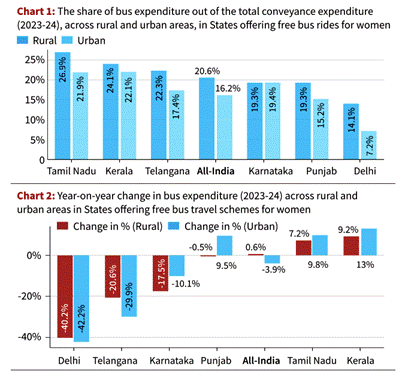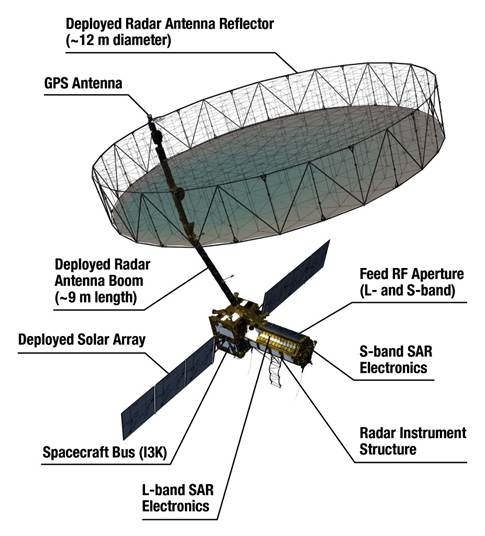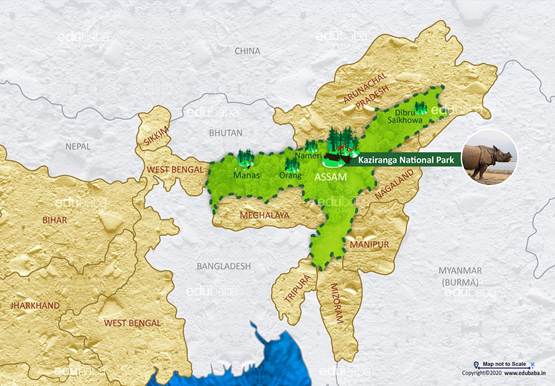Content:
- 3 Pak. terrorists behind Pahalgam killed: Centre
- Free bus schemes help, but rural India pays more to travel
- What did the ICJ say on climate obligations?
- Countdown on; NISAR satellite launch today
- Kaziranga in Assam records third-highest tiger density in India after Bandipur, Corbett
- Amid trade upheaval, India rethinks China blockade to further tech manufacturing
3 Pak. terrorists behind Pahalgam killed: Centre
Background
On April 22, 2025, a major terror attack took place at Baisaran meadow in Pahalgam, Jammu & Kashmir, resulting in the deaths of 26 civilians. The attack marked one of the deadliest incidents targeting civilians in the Union Territory in recent times.
Relevance : GS 3(Internal Security )
Recent Developments
On July 29, 2025, security forces conducted a targeted operation in the Dachigam area of Srinagar, leading to the killing of three foreign terrorists believed to be responsible for the April 22 attack.
Details of the Operation
- The terrorists were identified as:
- Suleman alias Faizal Jatt – Categorized as an “A-category” terrorist; also involved in the Gagangir attack (October 2024).
- Hamza Afghani
- Zibran
- All were Pakistani nationals and affiliated with the Lashkar-e-Taiba (LeT).
- The operation was carried out through coordinated efforts involving:
- Intelligence Bureau (IB)
- Indian Army
- Central Reserve Police Force (CRPF)
- Jammu & Kashmir Police
- A combination of human and technical intelligence was employed to track the terrorists’ movements.
Government Response
- The operation was confirmed by both the Prime Minister and the Union Home Minister in the Lok Sabha during a debate on Operation Sindoor, a broader counter-terror framework.
- It was emphasized that while local recruitment into militant groups has declined, infiltration attempts by foreign terrorists continue.
- The operation was presented as part of a larger effort to maintain internal security in Jammu & Kashmir and to prevent cross-border terrorism.
Operation Mahadev
- Separately, the Home Minister also referenced Operation Mahadev, under which the three terrorists involved in the Baisaran meadow killings were neutralized.
- The twin operations—Sindoor and Mahadev—are part of India’s ongoing security strategy to respond decisively to terrorist threats.
Strategic Implications
- Reinforces the trend of foreign-led terror operations in Kashmir, as local support reportedly diminishes.
- Demonstrates increasing reliance on multi-agency coordination and intelligence integration.
- Underlines India’s continued focus on counter-infiltration and post-incident accountability in terror-related incidents.
Free bus schemes help, but rural India pays more to travel
Context
A recent World Bank report noted that India lifted approximately 171 million people out of extreme poverty between 2011–12 and 2022–23. Extreme poverty, defined as living on less than $2.15 per day, has declined from 16.2% to 2.3% in this period. However, these statistics prompt further investigation into how household consumption patterns have evolved, particularly regarding expenditure priorities across rural and urban India.
Relevance : GS 1(Society) , GS 2(Social Issues)
Insights from the Household Consumption Expenditure Survey (HCES) 2023–24
1. Overview of Per Capita Expenditure
- Rural India: ₹4,122 per capita per month
- Urban India: ₹6,996 per capita per month
- Expenditure is divided into:
- Food: 47% (rural), 39% (urban)
- Non-food: The remaining share, which includes conveyance, health, education, housing, etc.
- The share of food consumption has declined over time, indicating a gradual shift in expenditure priorities.
2. Conveyance as a Major Non-Food Expense
- Conveyance accounts for 14% of total non-food expenditure on average.
- Bus travel forms the largest component of conveyance costs, particularly in rural areas:
- Rural: 20.6% of conveyance expenditure
- Urban: 16.2% of conveyance expenditure
- Rural dependence on buses is higher due to limited access to alternative transport modes.
3. State-Wise Trends
- High rural bus expenditure: Tamil Nadu, Kerala (around 25% of conveyance spending)
- Low rural bus expenditure: Uttar Pradesh, Odisha, Karnataka, Haryana (less than 20%)
- States offering free bus services for women as of 2025:
- Delhi, Tamil Nadu, Karnataka, Kerala, Telangana, Punjab, Jammu & Kashmir
4. Mixed Policy Impact
- Evidence on the impact of free bus schemes is mixed:
- Reduction in bus expenditure in: Delhi, Karnataka, Telangana
- Increase in bus expenditure in: Tamil Nadu, Kerala
- At a national level:
- Urban India saw a 4% decline in bus expenditure
- Rural India saw a 0.6% increase, indicating limited rural policy impact
5. Income Group and Usage Paradox
- Contrary to expectations, higher-income households spend a larger share of their conveyance budget on buses.
- Possible explanation: Lower-income households (especially in rural areas) have lower transportation needs due to engagement in agriculture.
- No clear link between non-agricultural employment and bus usage in urban areas, suggesting broader usage beyond commuting.

Policy Recommendations
- Electrification of Public Transport:
- Transition from internal combustion engines to electric buses to reduce operational costs and ticket prices.
- Increase Bus Availability:
- Current national average: 17 buses per 1 lakh population
- Ministry benchmark: 60 per 1 lakh
- Poorly served states: Punjab, Uttar Pradesh, Odisha (fewer than 10 buses per 1 lakh people)
- Improve Bus Quality and Affordability:
- Upgrading infrastructure can reduce the economic burden on households, allowing reallocation of resources to health, education, or asset creation.
Conclusion
India’s declining poverty rates and shifting consumption patterns reflect socio-economic progress. However, the findings from HCES underscore persistent infrastructure deficits and uneven policy impact, especially in rural areas. Addressing conveyance costs through targeted investment and systemic improvements in public transport could significantly enhance household welfare and reduce regional disparities.
What did the ICJ say on climate obligations?
Context
On July 23, the International Court of Justice (ICJ) delivered an advisory opinion on the obligations of states to reduce anthropogenic greenhouse gas (GHG) emissions and the legal consequences of failing to do so. The opinion arrives at a time when multilateral climate action faces significant challenges, especially with reduced commitments from some developed nations.
Relevance : GS 3(Climate Change , Environment and Ecology )
Key Highlights of the ICJ Opinion
1. Reaffirmation of the Climate Regime’s Integrity
- The ICJ emphasised the continuity and cohesiveness of the entire international climate framework:
- UNFCCC (1992)
- Kyoto Protocol (1997)
- Paris Agreement (2015)
- This contrasts sharply with the view from some developed countries that the Paris Agreement is now the sole binding framework, making earlier instruments obsolete.
2. A Boost for the Global South
- The Court reaffirmed that developed countries (as listed in Annex I and II of the UNFCCC) have additional obligations, including:
- Climate finance
- Technology transfer
- Capacity building
- Reasserted the relevance of Common But Differentiated Responsibilities and Respective Capabilities (CBDR–RC) as the core guiding principle.
- Notably, it extended the applicability of CBDR–RC beyond climate treaties to potentially wider environmental law, such as biodiversity governance.
3. Nuanced View on Developmental Status
- Recognised the evolving nature of “developed” and “developing” country categories, citing the Paris Agreement’s addition of “in the light of national circumstances” to CBDR–RC.
- This introduces flexibility but may blur lines in future interpretations and negotiations.
Contentious Interpretation of the Paris Temperature Target
1. Paris Agreement Language (Article 2.1(a)):
- Original Goal: Keep global temperature rise “well below 2°C”, while “pursuing efforts” for 1.5°C.
- ICJ’s View: Treats the 1.5°C target as the de facto obligation, based on recent UNFCCC COP decisions.
2. Issues Raised:
- The Court’s interpretation implies that implementation decisions can amend treaty obligations, a contentious legal stance.
- Ignores the reality that the 1.5°C threshold may be exceeded imminently, and offers no legal roadmap for that eventuality.
- Uncritical reliance on IPCC’s AR6 projections for emission cuts, which themselves do not account for equity or CBDR–RC, as acknowledged even in recent UNFCCC Bonn negotiations.
Enforcement of Climate Obligations: Limited Advances
- While extensively reviewing obligations of conduct vs. obligations of result, the Court remains within existing international law paradigms:
- Obligations of conduct (e.g., mitigation efforts) are recognised, but are not enforceable as guarantees of outcome.
- Stronger enforcement is limited to procedural compliance, such as submission of Nationally Determined Contributions (NDCs).
- The opinion implies that any enforcement is case-specific and dependent on judicial forums with relevant jurisdiction.
Gaps in the Opinion: A Global South Perspective
1. Developmental Constraints Ignored
- The opinion largely neglects the developmentalchallenges of the global South:
- Lack of carbon space threatens energy access and poverty eradication.
- Low-carbon transitions remain financially and technologically inaccessible for many developing countries.
2. Limited Recognition of Systemic Inequities
- Equity and CBDR–RC are acknowledged only as interpretive principles, not as sources of new obligations.
- Judge Xue Hanqin, in a separate opinion, highlights this omission, noting that a supportive international economic order is essential for sustainable development and climate justice.
Potential for Litigation, but Limited Global Impact
- The opinion may serve as a catalyst for litigation at the domestic or regional level, especially by climate-vulnerable countries.
- It opens pathways for claims of reparation or compensation, contingent on establishing:
- Attribution
- Wrongfulness
- Causation
- It opens pathways for claims of reparation or compensation, contingent on establishing:
- However, its effect on international negotiations is expected to be modest.
- Existing fault lines between North and South remain unaddressed.
- Several judges’ separate opinions reflect concern that this was a missed opportunity for bold jurisprudence.
Conclusion
The ICJ advisory opinion reaffirms important principles such as CBDR–RC and the continued obligations of developed countries, offering some support to the global South. However, it falls short in terms of:
- Addressing developmental asymmetries
- Clarifying the legal consequences of exceeding climate thresholds
- Proposing a robust enforcement framework
Its potential lies more in its symbolic value and litigation support, rather than in reshaping global climate governance. For policymakers and negotiators from the global South, the opinion is both an affirmation and a cautionary signal, underscoring the need to persist with demands for equity, climate finance, and technological justice.
Countdown on; NISAR satellite launch today
Launch Details:
- Satellite: NASA-ISRO Synthetic Aperture Radar (NISAR)
- Weight: 2,392 kg
- Launch Vehicle: GSLV-F16 (Geosynchronous Satellite Launch Vehicle)
- Launch Site: Second Launch Pad, Satish Dhawan Space Centre, Sriharikota
- Orbit: 743-km Sun-Synchronous Orbit
- Launch Time: Scheduled for 5:40 p.m., Wednesday (July 30, 2025)
- Countdown: Began at 2:10 p.m., Tuesday (27.5-hour duration)
Relevance : GS 3(Science and Technology, Space)

Key Features of NISAR:
- Joint Mission: First collaborative satellite mission between NASA and ISRO.
- Synthetic Aperture Radar: Carries both L-band (by NASA) and S-band (by ISRO) radar systems for dual-frequency earth observation.
- Observation Capacity:
- Global coverage every 12 days
- All-weather, day-night imaging
- High-resolution data for long-term global change monitoring.
Applications:
- Disaster Management: Earthquakes, landslides, floods, and cyclones
- Agriculture & Forestry: Crop monitoring, forest biomass, and land use changes
- Climate Science: Glacier dynamics, sea-level rise, soil moisture
- Urban Planning & Infrastructure Monitoring
Collaborative Dimensions:
- India’s Contribution:
- Spacecraft bus
- S-band radar
- Launch vehicle and mission operations
- NASA’s Contribution:
- L-band radar
- Radar reflector boom
- Communication subsystems, GPS, and data handling systems
Institutional Collaboration:
- Duration: Over a decade of joint development
- COVID-19 Challenge: Despite the pandemic, engineers from both countries ensured continued integration and testing:
- ~65 ISRO engineers visited NASA’s Jet Propulsion Laboratory (JPL)
- ~175 NASA engineers visited ISRO facilities
- Strategic Significance: A model for future international collaborations in space and earth science.
Broader Implications:
- Space Diplomacy: Enhances strategic cooperation in civilian space technology
- Capacity Building: Mutual learning and technology transfer
- Earth Science Leadership: Positions both agencies at the forefront of next-gen environmental monitoring
Kaziranga in Assam records third-highest tiger density in India after Bandipur, Corbett
Key Highlights:
- Tiger Count (2024): 148 individuals
- 2022 Comparison: 104 tigers
- Method: Phase IV monitoring using camera traps (as per NTCA protocol)
- Duration: 103 days (Dec 2023 – Apr 2024)
- Area Surveyed: 1,307.49 sq. km
- Camera Traps: 293 units
- Images Captured: 4,011 images from 242 locations

Relevance : GS 3(Environment and Ecology)
Tiger Density Ranking (India):
Kaziranga Tiger Reserve now has the third-highest tiger density in India:
- Bandipur Tiger Reserve, Karnataka – 19.83 tigers/100 sq. km
- Corbett Tiger Reserve, Uttarakhand – 19.56 tigers/100 sq. km
- Kaziranga Tiger Reserve, Assam – 18.65 tigers/100 sq. km
Reasons for Increase in Tiger Count:
- First-time Sampling of the Biswanath Wildlife Division (added 27 new tiger records)
- Core Eastern Assam Wildlife Division count increased from 104 (2022) to 115 (2024)
- Nagaon Wildlife Division maintained a stable count of 6 tigers
Methodology:
- Technique Used: Spatially Explicit Capture-Recapture (SECR)
- Considered more ecologically accurate than traditional methods
- Coordinating Bodies:
- National Tiger Conservation Authority (NTCA)
- Wildlife Institute of India (WII)
- Assam Forest Department
Conservation Context:
- The Kaziranga landscape includes a mix of grasslands, semi-evergreen and tropical forests, and wetlands — ideal for supporting both tigers and their prey base.
- Conservation in the region has improved through:
- Anti-poaching efforts
- Habitat restoration
- Community-based initiatives
Challenges:
- Persistent threats include:
- Habitat fragmentation
- Human-wildlife conflict
- Infrastructure development pressures
- Climate change
- Agricultural encroachment
Political and Administrative Response:
- Chief Minister Himanta Biswa Sarma emphasized Kaziranga’s dual role in tiger conservation and habitat restoration, particularly noting actions against infiltration and forest degradation.
- He described the tiger as the “treasure of Assam’s forests.”

Tigers in India – Key Facts
- India hosts ~75% of the global wild tiger population.
As per Status of Tigers in India, 2022 report, estimated count: 3,682 tigers. - Top Tiger States (2022):
Madhya Pradesh (785), Karnataka (563), Uttarakhand (560), Maharashtra (444), Tamil Nadu (306). - Project Tiger (1973):
Launched to conserve tigers in the wild — now administered by the National Tiger Conservation Authority (NTCA) under the MoEFCC. - Tiger Reserves (as of 2024):
54 reserves, covering ~78,000 sq km, or 2.4% of India’s geographical area. - Recent Success – Kaziranga (2024):
- Tiger population rose from 104 (2022) to 148 (2024).
- Third-highest tiger density in India: 18.65 tigers/100 sq. km.
- Attributed to better monitoring and inclusion of new areas like Biswanath Wildlife Division.
Amid trade upheaval, India rethinks China blockade to further tech manufacturing
Context and Background
- Post-Galwan Policy Shift (2020):
Following border clashes in 2020, India imposed stricter FDI rules via Press Note 3, requiring prior government approval for investments from countries sharing land borders (mainly targeting China).
Key sectors like telecom, electronics, and infrastructure were effectively blocked to Chinese firms. - Strategic Recalibration (2023–25):
Amid changing global dynamics and growing domestic manufacturing ambitions (e.g., Make in India, PLI schemes), India is cautiously rethinking its restrictions on Chinese firms, especially in non-strategic sectors.
Relevance : GS 2(International Relations)
Key Developments
Signs of Thaw: Gradual Allowance
- Dixon-Loncheer Partnership:
- Indian firm Dixon Technologies entered a joint venture with China-based Loncheer, with approval from India’s IT Ministry.
- This venture focuses on manufacturing electronics, including smartphones, tablets, wearables, and automotive components.
- About 74% of Dixon’s components in this space will come from China.
- Government Softening Stance:
- Policy think tanks like NITI Aayog have recommended easing FDI norms for China-linked entities in specific areas to boost exports.
- Recent moves include inviting Chinese firms to invest in India’s new Economic Survey 2023–24, signaling calibrated acceptance.
Balancing Act: Trade vs Security
- Continued Strategic Restrictions:
- Despite softening in electronics, sectors like defense, critical minerals, and core assembly remain largely off-limits.
- India remains wary of supply chain dependence, particularly in view of geopolitical volatility.
- Diplomatic Engagements:
- External Affairs Minister Jaishankar visited China, stressing the need for cooperation without conflict, while acknowledging persistent challenges in border resolution.
Implications for India’s Manufacturing and Trade
Electronics Sector Shifts
- Reduced Reliance? Not Yet Fully.
- China and Hong Kong remain dominant in electronics imports, contributing over 50% of total inputs.
- India’s smartphone exports to the US rose to 36% (early 2025), with China’s share in the same market dropping to 11%, indicating India’s growing role in global value chains.
- However, most components still come from Chinese or Chinese-backed firms.
Geopolitical and Trade Realignment
- India’s Dual Strategy:
- Aims to reduce over-dependence on Chinese capital while still using Chinese expertise to bolster manufacturing.
- Restrictive FDI continues in strategic sectors but is selectively relaxed in high-export-potential industries.
- Global Trade Tensions:
- China has imposed restrictions on firms doing business with India and has curbed rare earth exports.
- These retaliatory actions affect India’s electronics and renewable energy industries, both of which are heavily reliant on critical Chinese inputs.
Takeaways
- Strategic Autonomy vs Economic Integration:
India seeks to balance national security concerns with manufacturing competitiveness, particularly under PLI schemes and global supply chain diversification. - FDI Policy Evolution:
Future FDI policies may adopt a sector-specific and risk-calibrated approach, allowing non-sensitive investments from Chinese entities while shielding critical infrastructure. - China’s Role in Global Supply Chains:
Despite geopolitical tensions, Chinese companies remain integral to electronics manufacturing. India’s long-term success depends on developing indigenous capabilities and diversified sourcing.



